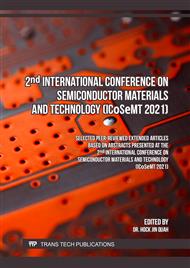p.37
p.43
p.51
p.57
p.67
p.73
p.79
p.87
p.93
Analysis of Transmission Performance for Fine Pitch Interconnect
Abstract:
Wire bonding is the preferred interconnection in the IC packaging. Understanding the electrical performance of bonding wire as transmission line is utmost important. To date, there is very limited studies on the transmission performance of fine pitch bare bonding wire especially the insulated wires. This paper investigated the transmission performance of single bare bonding wires and insulated bonding wires with different wire material, wire diameter, bonding height, insulation thickness at high frequency. The simulation analysis shows that when the frequency increases above 15Ghz, the effect of the geometric parameters has no significant different to the transmission performance. The thickness of the insulation between 0.1μm to 0.3μm reacted similar performance for return loss and insertion loss across all frequency
Info:
Periodical:
Pages:
67-72
Citation:
Online since:
May 2023
Price:
Сopyright:
© 2023 Trans Tech Publications Ltd. All Rights Reserved
Share:
Citation:



